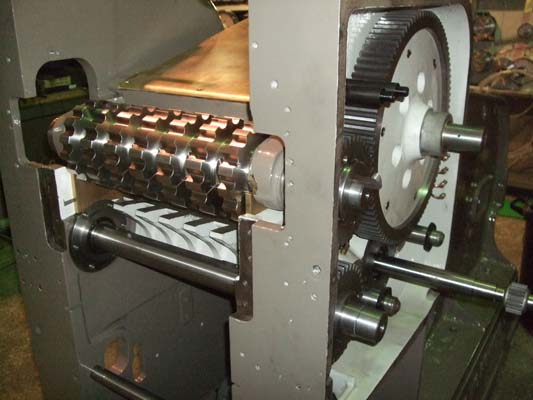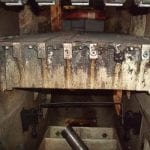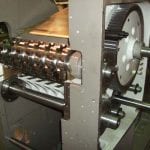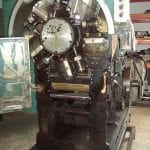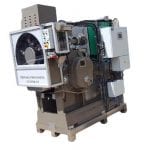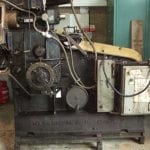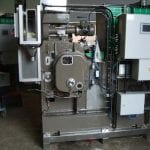Even as cigarette sales stagnate, engineers keep busy improving the efficiency, reliability and functionality of tobacco machinery.
By George Gay
The sales director of Godioli e Bellanti, Lorenzo Curina, has a challenge for us based on the fact that he doesn’t believe anyone could tell whether a used tobacco machine, after being reconditioned by his company, was used or new.
Such easygoing enthusiasm seems to be built into Lorenzo’s DNA, so he doesn’t always use the term “reconditioned” machinery. Asked to describe Godioli e Bellanti in a few words, he said, in an emailed reply, that for almost 100 years tobacco machines had been the company’s “daily bread” and that today it was an engineering company specializing in designing, manufacturing and supplying new tobacco machines and complete processing lines, while also “revitalizing” and giving a “new life” to used tobacco machines.
In fact, Lorenzo laid down his challenge (I’m not sure, but there might be a bottle of wine on offer) in answer to another question—one about whether Godioli e Bellanti was able to obtain the base machines required to fulfill its customers’ requests for reconditioned machinery. Yes, he said, the company had bought many used leaf tobacco processing lines at the time when tobacco factories were closing in Europe, and it still had warehouses full of used tobacco machines. So customers had a wide range of choice. Godioli e Bellanti, he added, tongue-in-cheek, even tried to accommodate those who wanted machines of very particular dimensions, that were hardly used, that performed as well as or better than new machines and that came at a very low price!
In answer to the same question, Ron Woodthorpe, of Hampshire Tobacco Machinery Services (HTMS), said that his company tried to fulfill its customers’ needs from its own inventory, but that, in any case, it had good sources of supply in both Europe and the U.S., even though some machinery was destroyed, rather than sold, when it was no longer required. One other challenge was that whereas a certain donor machine might be available, the cost of acquiring it would render a rebuild prohibitively expensive.
Peter Woodthorpe, also of HTMS, said that fulfilling the needs of customers with reconditioned machinery could be a challenge, which was why over the years the company had developed new machines it could build from stock and offer for a price similar to that of a reconditioned unit, given the purchase cost of a donor machine was factored in. Of course, HTMS cannot cover all bases with this option, but one important example of such a new-build replacement concerns the Molins HLP 1-2, in the place of which HTMS builds and offers its own HLP machine, the XL515.
Auctions
I was particularly interested in the question of donor equipment after having seen an advertisement for an auction in the U.S. that included tobacco machines. The online auction of goods was being conducted (June 7–14) as I wrote this piece by the Iron Horse Auction Co. of Rockingham, North Carolina, which had been ordered by a bankruptcy court to sell late-model and rebuilt cigarette manufacturing equipment owned by North Carolina Tobacco International.
Clearly, such auctions would not comprise a big source of tobacco machines, though in this case the quality of some of them would have no doubt proved attractive. In an email exchange, William B. Lilly Jr., auctioneer/realtor at Iron Horse, told me that auctions involving tobacco machinery were quite rare, usually occurring when a company filed for bankruptcy protection. Generally, tobacco machines were either sold by dealers or destroyed to prevent the revelation of trade secrets.
In fact, William told me that the June auction was only the second or third involving tobacco manufacturing equipment in North Carolina that he was aware of since 2011.
It was what he referred to as a medium-sized auction, but the unique thing about it, he said, was that it featured what to him were late-model machines, a 2009 Decoulfe rod maker and Hauni Max-S tipping unit, and a 2010 Decoulfe rod maker and Hauni Max-S tipping unit.
Most of the machines that William has dealt with in the past have been rebuilt several times. “The demand is high for the late-model machines and not above medium for the older rebuilt machines,” he said in an email. “The demand is created through the competitive bidding amongst domestic contract makers and international makers. We give these machines a time and place where they will be sold to the highest bidder. This differs from the traditional sale method where a machine may sit on the market for up to 12 months or longer.”
The June auction created international interest, perhaps because of the machinery on offer, which also included a Molmac MK-9 PLC rod maker and a Molmac Max-S tipping unit; a Molmac HLP-R packer; an MTS-HLP packer; an AMF packer; wrappers; boxers; tray fillers and a tray unloader. William said he had been contacted by tobacco manufacturers from the European Union, the Middle East, Asia and the U.S.
I asked whether the tobacco manufacturing machinery buyers tended to be tobacco manufacturers themselves or if they were more likely to be machinery dealers. “It is a mix between manufacturers and dealers,” said William. “The dealers usually get the bidding started by placing wholesale bids early in the auction. Then the tobacco manufacturers will usually jump in on the last few days of the auction when they see the machines selling for wholesale prices and then bid the prices up to retail levels.”
Finally, I asked whether Iron Horse had to check that the buyers were not involved in the counterfeit-tobacco-product business. “We sell the machines ‘as is, where is’ and it is the buyer’s responsibility to determine the feasibility for their intended use and any permitting required by local, state or federal regulatory agencies,” said William. “The current auction has been ordered by the United States Bankruptcy Court, Middle District of North Carolina, and the Alcohol and Tobacco Tax and Trade Bureau of the United States Department of the Treasury is aware of the auction.”
As-new
It stands to reason that machinery sold at auction is going be offered “as is,” but “as is” equipment is a business offering that HTMS has steered away from, even though Peter says it often receives enquiries for such machines. “All of our machinery is supplied to an as-new condition, tried and tested with a warranty for one year based on a single shift,” he said in an emailed reply to questions from Tobacco Reporter. “A full spares support service is available and usually a budget for such items is included within a quotation.”
HTMS, which Peter described as a well-established re-engineering business with more than 50 years’ experience in the tobacco industry, will always recondition a customer’s machinery. “We recently completed a project which included four machines all the same type and format for a high-end customer in the USA,” he said. “A collection of the best donor machines were selected and sent to us in the U.K. for an ‘as new’ ground-up overhaul, with many upgrade features to the customer’s specific requirement.”
Meanwhile, Ron said that HTMS was seeing a rise in customers wanting to refurbish, upgrade and size-change machinery they owned. In this case, HTMS could update mechanical, electrical and safety systems to improve the efficiency, reliability and functionality of equipment. The company had the ability to give a new lease of life to used machines, improving output by 30–70 percent in respect of some original Molins and Hauni machines.
Both Godioli e Bellanti and HTMS say that their businesses are about 95 percent tobacco industry focused. In the case of HTMS, which occasionally supplies services to, for instance, the tea manufacturing industry, most of its tobacco business is focused on making and packing equipment, and downstream machinery, including high-speed tax-stamp applicators for packs and cartons, along with a related spare parts service.
Customer types

Godioli e Bellanti will accommodate both requests for the supply of reconditioned equipment to customers looking for it to provide new-to-them equipment and requests from customers looking to have their own equipment reconditioned. Lorenzo said that most of the customers who were interested in buying reconditioned tobacco machines were “very new” investors in the tobacco sector, and that they were initially attracted to buying reconditioned equipment because of the lower investment such equipment required.
Although they didn’t want to invest too much initially, they felt that the sector could be profitable, and therefore they wanted a quality processing line. And, Lorenzo added, it was undoubtedly true that during the past 15–20 years Godioli e Bellanti had earned an excellent reputation for reconditioning, rebuilding and refurbishing. “We do not brush the old with a few brushstrokes of paint!” he said. “For us reconditioning means really reconditioning: replacing ball bearings, checking the mechanisms, repairing the valves, testing electrical motors, and evaluating the characteristics and performances of fans.”
On the other hand, multinational tobacco companies were usually interested in having whole plants relocated, and on such occasions they would take the opportunity to have machines reconditioned. “The old and well-tested organization of our company allows us to offer tobacco multinationals a complete service: from dismantling to shipping, from remounting and reconditioning up to the final start-up and commissioning of the reconditioned machines,” Lorenzo said.
Asked what the in-demand reconditioned machines were, Lorenzo said that, in fact, most requests concerned complete processing lines, though the company was frequently requested to supply reconditioned “key-machines.” Without trying to exaggerate the importance of Godioli e Bellanti, said Lorenzo, the most widely demanded used and reconditioned machine was the Godioli e Bellanti press. Then came tobacco redriers, conditioning cylinders, and direct conditioning cylinders (DCCs).
The next question concerned where, geographically, demand for reconditioned equipment was coming from. Easy question, easy reply, said Lorenzo. A big part of the tobacco industry had moved out of Europe and North America; so inquiries and demands for reconditioned tobacco machines tended to come from all countries, except those in Europe and North America.
Peter, on the other hand, said that the spread of HTMS’ customer base for reconditioned machinery ranged from all parts of North America, through Eastern Europe and the Far East to the depths of the jungles of Papua New Guinea.
And, in the past few years, its customers included businesses ranging from those of the largest manufacturers to new start-ups. In the case of the former, some of the machinery has comprised makers and packers for the high-speed manufacture of cigarillos.
And as to the types of machines in demand? Peter said that the range of enquiries was broad: from tobacco cutters, to cigarette makers (MK8/MK9/G4), to hard- and soft-pack packing lines. But, he added, the hard box HLP was the first choice throughout the world.
It was always thus.

